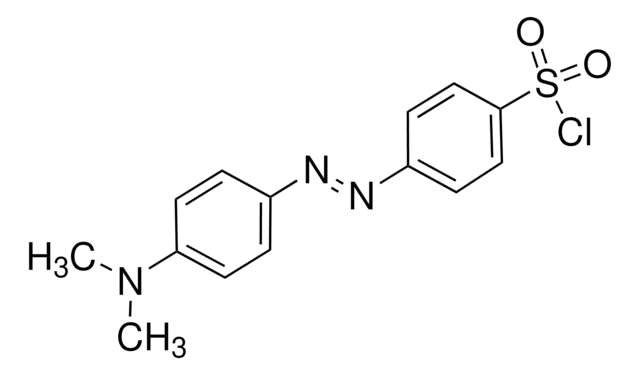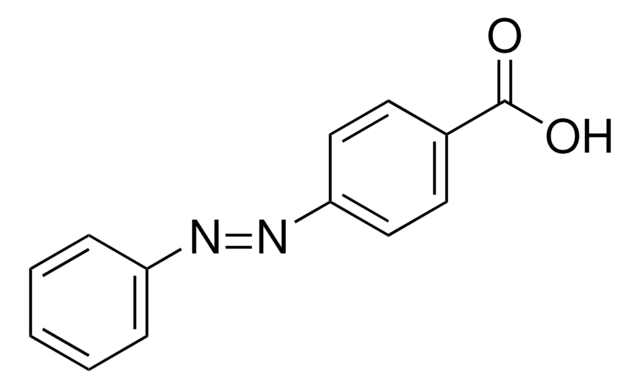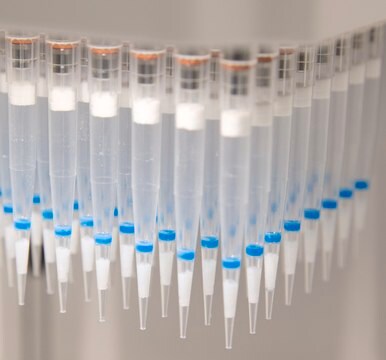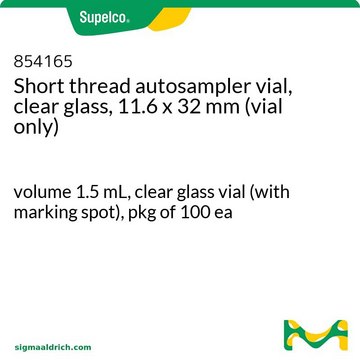おすすめの製品
グレード
derivatization grade ((HPLC))
for HPLC derivatization
品質水準
アッセイ
98.0-102.0% (AT)
フォーム
crystals
品質
LiChropur™
テクニック
HPLC: suitable
mp
185 °C (dec.) (lit.)
SMILES記法
CN(C)c1ccc(cc1)\N=N\c2ccc(cc2)S(Cl)(=O)=O
InChI
1S/C14H14ClN3O2S/c1-18(2)13-7-3-11(4-8-13)16-17-12-5-9-14(10-6-12)21(15,19)20/h3-10H,1-2H3/b17-16+
InChI Key
VTVWTPGLLAELLI-WUKNDPDISA-N
類似した製品をお探しですか? 訪問 製品比較ガイド
詳細
Amino groups are common to many biological compounds and many amines used in pharmaceuticals. Most of these compounds show weak absorption in direct HPLC analysis with UV-VIS detection. However, strongly absorbing derivatives of amines can be easily detected by HPLC with high sensitivity even when present at low concentrations. Primary and secondary amino groups are usually derivatized as aromatic derivatives by nucleophilic substitution reactions using reagents such as arylsulfonyl chlorides.
4-(Dimethylamino)azobenzene-4′-sulfonyl chloride, a well-known UV-labeling agent, is generally used for the derivatization of N-terminal amino acids, imidazole derivatives, polyamines, etc. prior to their chromatographic determination due to the former′s capacity to covalently bind to the substrates. Its derivatives typically absorb UV radiation between the range of 436-460 nm. This method of derivatization is regarded as superior compared to other methods owing to the simplicity of the procedure, high stability and reproducibility, best resolution of the analytes, etc.
4-(Dimethylamino)azobenzene-4′-sulfonyl chloride, a well-known UV-labeling agent, is generally used for the derivatization of N-terminal amino acids, imidazole derivatives, polyamines, etc. prior to their chromatographic determination due to the former′s capacity to covalently bind to the substrates. Its derivatives typically absorb UV radiation between the range of 436-460 nm. This method of derivatization is regarded as superior compared to other methods owing to the simplicity of the procedure, high stability and reproducibility, best resolution of the analytes, etc.
アプリケーション
4-(Dimethylamino)azobenzene-4′-sulfonyl chloride may be used to derivatize biogenic amines, primary amino acids, melamine, and hydroxyproline and proline extracted from various biological samples prior to their determination using high performance liquid chromatography (HPLC) technique to increase their detection sensitivity.
法的情報
LiChropur is a trademark of Merck KGaA, Darmstadt, Germany
シグナルワード
Danger
危険有害性情報
危険有害性の分類
Skin Corr. 1B
保管分類コード
8A - Combustible corrosive hazardous materials
WGK
WGK 3
引火点(°F)
Not applicable
引火点(℃)
Not applicable
適用法令
試験研究用途を考慮した関連法令を主に挙げております。化学物質以外については、一部の情報のみ提供しています。 製品を安全かつ合法的に使用することは、使用者の義務です。最新情報により修正される場合があります。WEBの反映には時間を要することがあるため、適宜SDSをご参照ください。
Jan Code
89802-100MG:
89802-500MG:
89802-VAR:
89802-BULK:
Sensitive determination of melamine in milk and powdered infant formula samples by high-performance liquid chromatography using dabsyl chloride derivatization followed by dispersive liquid-liquid microextraction
Faraji M and Adeli M
Food Chemistry, 221, 139-146 (2017)
Journal of Chromatography Library
J. Chromatogr. Library, 70(2), 229-241 (2005)
ライフサイエンス、有機合成、材料科学、クロマトグラフィー、分析など、あらゆる分野の研究に経験のあるメンバーがおります。.
製品に関するお問い合わせはこちら(テクニカルサービス)
![4-[4-(ジメチルアミノ)フェニルアゾ]安息香酸 N-スクシンイミジル エステル ≥98.0% (HPLC)](/deepweb/assets/sigmaaldrich/product/structures/120/235/500b5276-3ce2-43b7-9588-3883f13d4ff7/640/500b5276-3ce2-43b7-9588-3883f13d4ff7.png)





